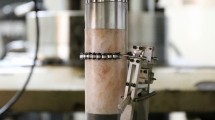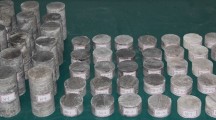Abstract
Cyclic loading tests of rock salt were performed to investigate the characteristics of damage evolution of the surrounding rock in gas caverns. In this experiment, the cyclic loading process was carried out on seven stress levels from 20 to 86 % of the uniaxial compressive strength. The sine wave with a frequency of 1 Hz was adopted in the cyclic loading test. Experimental results show that at the first stress level, the damage evolution is rather limited or negligible under cyclic loading, which is controlled within the elastic limit. With the increase in stress level, the damage evolution becomes more evident. An increasing tendency of damage variable can be observed if the stress level surpasses 40 % of the uniaxial compressive strength. A maximum damage value of around 0.95 is recorded when the stress level is over 85 % of the uniaxial strength. In this paper, a damage evolution equation is also introduced and good agreement is obtained with the experimental data. Based on the experimental data, it is shown that the design practice of gas cavern concerning the degree of strength utilization of the surrounding rock is rather conservative considering the reducing effect of the minimal gas pressure on the damage evolution.




Similar content being viewed by others
References
Aubertin M, Sgaoula J, Gill DE (1993) A damage model for rock salt: application to tertiary creep. In: 7th symposium on Salt, Kyoto, Japan, pp 117–125
Bagde MN, Petros V (2005) Waveform effect on fatigue properties of intact sandstone in uniaxial cyclical loading. Rock Mech Rock Eng 38(3):169–196
Chen WZ, Tan XJ, Wu GJ, Yang JP (2009) Research on gas seepage law in laminated salt rock gas storage. Chin J Rock Mech Eng 28(7):1297–1304 (in Chinese)
Chen L, Shao JF, Huang HW (2010) Coupled elastoplastic damage modeling of anisotropic rocks. Comput Geotech 37(1–2):187–194
Cosenza PH, Ghoreychi M, Bazargan-Sabet B, de Marsily G (1999) In situ rock salt permeability measurement for long term safety assessment of storage. Int J Rock Mech Min Sci 36(4):509–526
Eberhardt E, Stead D, Stimpson B (1999) Quantifying progressive pre-peak brittle fracture damage in rock during uniaxial compression. Int J Rock Mech Min Sci 36(3):361–380
Fuenkajorn k, Phueakphum D (2010) Effects of cyclic loading on mechanical properties of Maha Sarakham salt. Int J Rock Mech Min Sci 112:43–52
Hou Z, Wu W (2003) Improvement of design of storage cavity in rock salt by using the Hou/Lux constitutive model with consideration of creep rupture criterion and damage. Chin J Geotech Eng 25(1):105–108
Lemaitre J (1985) A continuous damage mechanics model for ductile fracture. J Eng Mater Technol 107(1):83–89
Lindblom UE (1997) Design criteria for the Brooklyn Union gas storage caverns at JFK airport, New York. ISRM international symposium 36th US. rock mechanics symposium. Int J Rock Mech Min Sci 34(3–4):179e1–179e16
Liu JF, Xie H, Xu J, Yang CH (2008) Experimental study on damping characteristics of rock under cyclic loading. Chin J Rock Mech Eng 27(4):712–717 (in Chinese)
Liu JF, Pei JL, Ma K, Zhou H, Hou Z (2010) Damage evolution and fractal property of salt rock in tensile failure. In: Proceedings of the international symposium on underground storage of CO2 and energy, Beijing, China, pp 105–112
Liu JF, Xu J, Li QS, Li GL (2010) Experimental research on damping parameters of rock under cyclic loading. Chin J Rock Mech Eng 29(5):1036–1041 (in Chinese)
Lux KH, Hou Z, Duesterlohn U (1999) Some new aspects about the mechanical behavior of salt cavities and about the geotechnical proof of safety, part 1: theories analysis. Erdoel Erdgas Kohle 115(3):122–127 (in German)
Mohd Salim NA, Mohamed Z (2012) Cyclic loading effect on the uniaxial compressive strength of weathered rock. In: International symposium on advances in science and technology, 6th SAS Tech 2012, Kuala Lumpur, Malaysia
Peng RD, Xie H, Ju Y (2007) Analysis of energy dissipation and damage evolution of sandstone during tensile process. Chin J Rock Mech Eng 26(12):2526–2531 (in Chinese)
Schulze T, Popp HK (2001) Development of damage and permeability in deforming rock salt. Eng Geol 61(2/3):163–180
Staudtmeister K, Rokahr RB (1997) Rock mechanical design of storage caverns for natural gas in rock salt mass. ISRM international symposium. 36th US. rock mechanics symposium, Int J Rock Mech Min Sci 34(3–4):300e1–300e13
The professional standard compilation group of People’s Republic of China (1999) GB/T50266-99 Standard for tests method of engineering rock mass. China Planning Press, Beijing (in Chinese)
Wu W, Yang CH, Hou Z (2005) Investigation on studied situations associated with mechanical aspects and development for underground storage of petroleum and natural gas in rock salt. Chin J Rock Mech Eng 24(S2):5561–5568 (in Chinese)
Xie H, Chen ZD (1988) Study of a rock model with continuous damage mechanics. J China Coal Society 1:33–42 (in Chinese)
Xie H, Ju Y (1997) Discuss on elastic modulus method of classical damage definition. Mech Eng 19(2):1–5 (in Chinese)
Xie H, Ju Y, Li LY, Peng RD (2008) Energy mechanism of deformation and failure of rock masses. Chin J Rock Mech Eng 27(9):1329–1340 (in Chinese)
Xie LZ, Zhou HW, Xie H (2009) Research advance of CO2 storage in rock salt caverns. Rock Soil Mech 30(11):3324–3330 (in Chinese)
Xie H, Liu JF, Ju Y, Li J, Xie LZ (2011) Fractal property of spatial distribution of acoustic emissions during the failure process of bedded rock salt. Int J Rock Mech Min Sci 48(8):1344–1351
Yang CH, Liang WG, Wei DH, Yang HJ (2005) Investigation on possibility of energy storage in salt rock in China. Chin J Rock Mech Eng 24(24):4409–4417 (in Chinese)
Acknowledgments
The authors are grateful for the financial support from the National Natural Science Foundation of China (Grant No. 51120145001, 51104101, 51134018), the National Basic Research Projects of China (Grant No. 2011CB201201, 2010CB226802, 2010CB732005), State Key Laboratory of Geohazard Prevention and Geoenvironment Protection (Grant No. SKLGP2013K016). The authors wish to offer their gratitude and regards to the colleagues who contributed to this work.
Author information
Authors and Affiliations
Corresponding author
Rights and permissions
About this article
Cite this article
Liu, J., Xie, H., Hou, Z. et al. Damage evolution of rock salt under cyclic loading in unixial tests. Acta Geotech. 9, 153–160 (2014). https://doi.org/10.1007/s11440-013-0236-5
Received:
Accepted:
Published:
Issue Date:
DOI: https://doi.org/10.1007/s11440-013-0236-5




